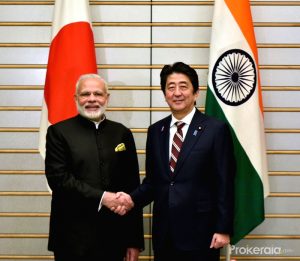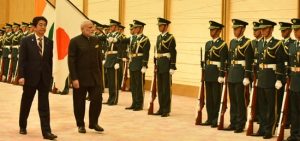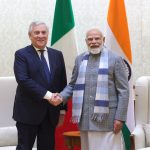 TOKYO: Marking the transformative moment in India-Japan relations, Asia’s second and third largest economies signed a historic nuclear pact that signals a new dawn in their burgeoning relations, and makes Tokyo an indispensable partner in India’s development journey.
TOKYO: Marking the transformative moment in India-Japan relations, Asia’s second and third largest economies signed a historic nuclear pact that signals a new dawn in their burgeoning relations, and makes Tokyo an indispensable partner in India’s development journey.
Leap of Faith: India-plus exception
In Kantei, the stately glass-and-wood office of Japan’s prime minister, there was an atmosphere of quiet celebration as Tokyo made a leap of faith and exceptionalized India by signing its first nuclear deal with a country which hasn’t signed the Nuclear Non-Proliferation Treaty (NPT). Prime Minister Narendra Modi and his Japanese counterpart Shinzo Abe smiled as India’s Foreign Secretary S. Jaishankar and Japan’s ambassador to India signed the pact and shook hands warmly.
It was an India-plus exception and underscored New Delhi’s growing profile in Tokyo’s strategic calculus. For Mr Abe it wasn’t an easy decision given Japan’s entrenched nuclear non-proliferation orthodoxy and its singular experience of being attacked by nuclear bombs, but in the end his strategic vision of the potential of the world’s fastest growing economy and an emerging security provider won.
 The deal marked a fitting finale of six years of tortuous negotiations, with the two sides going through every comma and semi-colon in the agreed text, which saw a rigorous legal and technical scrub in the final stages. The nuclear agreement is clearly the big deal as it will not only pave the way for the export of cutting-edge nuclear reactors to India, but will also enable US and French companies to fast-track their nuclear business with India. Japan’s Hitachi and Toshiba are major stakeholders and part owners of leading US companies like General Electric and Westinghouse, and French nuclear colossus Areva.
The deal marked a fitting finale of six years of tortuous negotiations, with the two sides going through every comma and semi-colon in the agreed text, which saw a rigorous legal and technical scrub in the final stages. The nuclear agreement is clearly the big deal as it will not only pave the way for the export of cutting-edge nuclear reactors to India, but will also enable US and French companies to fast-track their nuclear business with India. Japan’s Hitachi and Toshiba are major stakeholders and part owners of leading US companies like General Electric and Westinghouse, and French nuclear colossus Areva.
Green & Clean
In their statements to the media, the leaders of India and Japan captured the historical import of the nuclear pact. “Today’s signing of the agreement for cooperation in peaceful uses of nuclear energy marks a historic step in our engagement to build a clean energy partnership,” said Mr Modi. “It (the agreement) is in line with Japan’s ambition to create a world without nuclear weapons.” “This agreement is a legal framework that India will act responsibly in peaceful uses of nuclear energy and also in non-proliferation regime even though India is not a participant or signatory of NPT,” he said.
India-Japan pact & 123
 The India-Japan deal is by far as the most comprehensive one and will be ready for implementation soon after it is ratified by Japan’s parliament. Allaying apprehensions that the pact may be derailed by nuclear ayatollahs in Japan’s parliament, Mr Jaishankar said: “We conclude agreements in the expectation that they are ratified.”
The India-Japan deal is by far as the most comprehensive one and will be ready for implementation soon after it is ratified by Japan’s parliament. Allaying apprehensions that the pact may be derailed by nuclear ayatollahs in Japan’s parliament, Mr Jaishankar said: “We conclude agreements in the expectation that they are ratified.”
The text of the nuclear agreement has not been made public so far, but Mr Jaishankar underlined “striking similarities” with the 123 agreement India signed with the US. It’s an improvised and updated version of the 123 agreement, albeit with Japan-specific features. The major difference is that whereas the India-US deal was done in four phases, the India-Japan nuclear pact has compressed all four stages, including a 123 agreement, reprocessing, administrative arrangements and NSG, into one overarching pact. What this means is that no additional pact or add-on is required for implementation once it is ratified by Diet.
Given Japan’s special sensitivities and concerns, Mr Jaishankar added that nuclear safety and security have a more prominent place in the India-Japan nuclear pact. The testing clause is roughly along the lines in the India-US 123 pact which entails the cessation of nuclear cooperation in case India conducts a nuclear test. Mr Abe has called for a continuing dialogue with India on the universalisation of NPT, an early coming into force of CTBT and expediting negotiations on New Delhi joining the FMCT. Japan’s nuclear theology is an intricate labyrinth, but in the end India’s impeccable record on non-proliferation won the day.
The Big Picture
 The deal’s importance goes much beyond nuclear commerce, and paves the stage for a marked acceleration of India-Japan relations in all areas, including trade and investment, green energy and connectivity. This was clear from the signing of 10 agreements and a soaring vision of India-Japan relations which will draw Asia’s two leading democracies in a tighter strategic embrace in the Indo-Pacific region. The deal also signalled a more proactive and expanded role by Japan in key schemes of national renewal, including Make in India, Digital India and Skill India. The pact on Japan setting up a training institute in India for manufacturing skills promises to be a game-changer in moving the Indian economy higher up the value chain. Above all, the deal underscored (as both Mr Abe and Modi highlighted) that a stronger India and a stronger Japan are in each other’s interests and are central to the flowering of an Asian Century.
The deal’s importance goes much beyond nuclear commerce, and paves the stage for a marked acceleration of India-Japan relations in all areas, including trade and investment, green energy and connectivity. This was clear from the signing of 10 agreements and a soaring vision of India-Japan relations which will draw Asia’s two leading democracies in a tighter strategic embrace in the Indo-Pacific region. The deal also signalled a more proactive and expanded role by Japan in key schemes of national renewal, including Make in India, Digital India and Skill India. The pact on Japan setting up a training institute in India for manufacturing skills promises to be a game-changer in moving the Indian economy higher up the value chain. Above all, the deal underscored (as both Mr Abe and Modi highlighted) that a stronger India and a stronger Japan are in each other’s interests and are central to the flowering of an Asian Century.
.
Author Profile

- Manish Chand is Founder and Editor-in-Chief of India Writes Network (www.indiawrites.org) and India and World, a pioneering magazine focused on international affairs. He is CEO, Centre for Global India Insights, an India-based think tank focused on global affairs.
Latest entries
 India and the WorldDecember 12, 2025India-Italy bonding: Tajani’s visit raises the bar for business, maritime ties
India and the WorldDecember 12, 2025India-Italy bonding: Tajani’s visit raises the bar for business, maritime ties In ConversationNovember 26, 2025G20 is a Force for global Good
In ConversationNovember 26, 2025G20 is a Force for global Good articlesNovember 26, 2025Rescuing G20 from North-South divide: Ubuntu Moment
articlesNovember 26, 2025Rescuing G20 from North-South divide: Ubuntu Moment India and the WorldOctober 27, 2025Modi hails the century of India and ASEAN, backs ASEAN centrality
India and the WorldOctober 27, 2025Modi hails the century of India and ASEAN, backs ASEAN centrality







